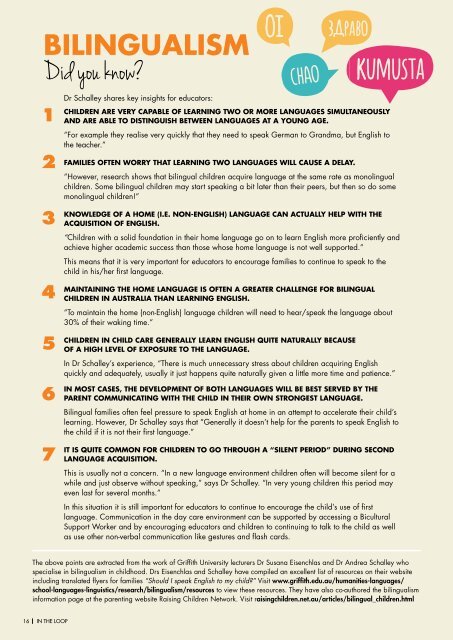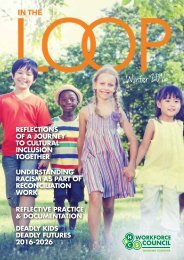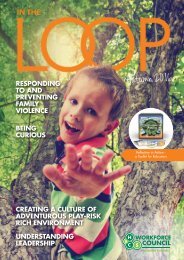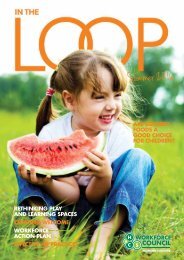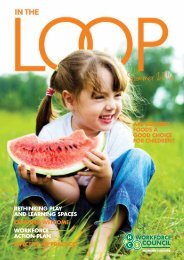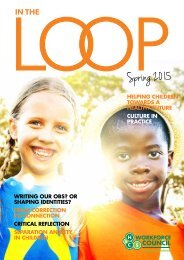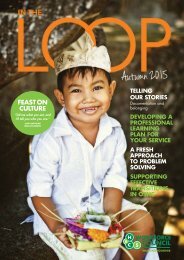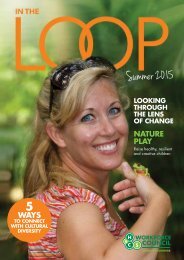Winter 2015
Create successful ePaper yourself
Turn your PDF publications into a flip-book with our unique Google optimized e-Paper software.
BILINGUALISM<br />
Did you know?<br />
1<br />
2<br />
3<br />
4<br />
5<br />
6<br />
7<br />
Dr Schalley shares key insights for educators:<br />
CHILDREN ARE VERY CAPABLE OF LEARNING TWO OR MORE LANGUAGES SIMULTANEOUSLY<br />
AND ARE ABLE TO DISTINGUISH BETWEEN LANGUAGES AT A YOUNG AGE.<br />
“For example they realise very quickly that they need to speak German to Grandma, but English to<br />
the teacher.”<br />
FAMILIES OFTEN WORRY THAT LEARNING TWO LANGUAGES WILL CAUSE A DELAY.<br />
“However, research shows that bilingual children acquire language at the same rate as monolingual<br />
children. Some bilingual children may start speaking a bit later than their peers, but then so do some<br />
monolingual children!”<br />
KNOWLEDGE OF A HOME (I.E. NON-ENGLISH) LANGUAGE CAN ACTUALLY HELP WITH THE<br />
ACQUISITION OF ENGLISH.<br />
“Children with a solid foundation in their home language go on to learn English more proficiently and<br />
achieve higher academic success than those whose home language is not well supported.”<br />
This means that it is very important for educators to encourage families to continue to speak to the<br />
child in his/her first language.<br />
MAINTAINING THE HOME LANGUAGE IS OFTEN A GREATER CHALLENGE FOR BILINGUAL<br />
CHILDREN IN AUSTRALIA THAN LEARNING ENGLISH.<br />
“To maintain the home (non-English) language children will need to hear/speak the language about<br />
30% of their waking time.”<br />
CHILDREN IN CHILD CARE GENERALLY LEARN ENGLISH QUITE NATURALLY BECAUSE<br />
OF A HIGH LEVEL OF EXPOSURE TO THE LANGUAGE.<br />
In Dr Schalley’s experience, “There is much unnecessary stress about children acquiring English<br />
quickly and adequately, usually it just happens quite naturally given a little more time and patience.”<br />
IN MOST CASES, THE DEVELOPMENT OF BOTH LANGUAGES WILL BE BEST SERVED BY THE<br />
PARENT COMMUNICATING WITH THE CHILD IN THEIR OWN STRONGEST LANGUAGE.<br />
Bilingual families often feel pressure to speak English at home in an attempt to accelerate their child’s<br />
learning. However, Dr Schalley says that “Generally it doesn’t help for the parents to speak English to<br />
the child if it is not their first language.”<br />
IT IS QUITE COMMON FOR CHILDREN TO GO THROUGH A “SILENT PERIOD” DURING SECOND<br />
LANGUAGE ACQUISITION.<br />
This is usually not a concern. “In a new language environment children often will become silent for a<br />
while and just observe without speaking,” says Dr Schalley. “In very young children this period may<br />
even last for several months.”<br />
In this situation it is still important for educators to continue to encourage the child’s use of first<br />
language. Communication in the day care environment can be supported by accessing a Bicultural<br />
Support Worker and by encouraging educators and children to continuing to talk to the child as well<br />
as use other non-verbal communication like gestures and flash cards.<br />
The above points are extracted from the work of Griffith University lecturers Dr Susana Eisenchlas and Dr Andrea Schalley who<br />
specialise in bilingualism in childhood. Drs Eisenchlas and Schalley have compiled an excellent list of resources on their website<br />
including translated flyers for families “Should I speak English to my child?” Visit www.griffith.edu.au/humanities-languages/<br />
school-languages-linguistics/research/bilingualism/resources to view these resources. They have also co-authored the bilingualism<br />
information page at the parenting website Raising Children Network. Visit raisingchildren.net.au/articles/bilingual_children.html<br />
16<br />
IN THE LOOP


